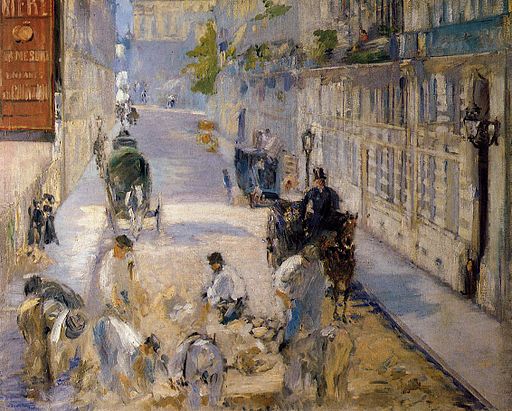
“The Rue Mosnier Dressed with Flags” by Édouard Manet depicts a Parisian street, decorated with French flags for the first national holiday, which occurred on 30 June 1878. It was called the “Fête de la Paix,” or in English, “Celebration of Peace.”
The Rue Mosnier, which is now called the Rue de Berne, could be seen from Manet’s studio at 4 Rue de Saint-Pétersbourg. This canvas shows the view from his second-floor window, with tricolor flags hanging from the buildings along the road.
Manet captured the holiday afternoon in the top half of the composition with a patriotic harmony of the reds, whites, and blues of the French flag that waved along the street.
In the bottom half of the composition is a one-legged man on crutches, possibly a veteran wounded in the Franco-Prussian War. Also, at the bottom is a man carrying a ladder, and on the left is a fence holding back the rubble from building works.
The urban street was a subject of interest for Impressionist and Modernist painters. Manet reflected the transformation and growth of the Industrial Age and how it impacted society.
Manet shows both the elegantly dressed and their hansom cabs and a worker carrying a ladder. He captured the cost of progress with the hunched amputee on crutches and the construction zone for a new train track.
Manet was interested in the sacrifices required for national pride and newfound industrial prosperity.
Commentators of the day remarked on the enthusiasm for this public holiday when the tricolor dominated the streets of Paris. Even hearses carrying the deceased to the cemetery were decked with the national flag.

“Road-menders in the Rue Mossnier” by Édouard Manet depicts the same street on a workday – Private Collection
First national holiday on 30 June 1878
This painting represents the first French official national celebration to take place following the defeat of Napoleon III in 1870.
The festivities also marked the 1878 Universal Exhibition and heralded the advent of the French Third Republic, established several months later.
To commemorate the recent Exposition Universelle, itself a celebration of prosperity and progress, the French government declared June 30, 1878, a national holiday.
The holiday called the “Celebration of Peace” also marked France’s recovery from the disastrous Franco-Prussian War of 1870-1871 and the bloody, divisive Paris Commune that followed.
Claude Monet produced similar paintings of flags on the Rue Montorgueil and Rue Saint-Denis in Paris in 1878. These works were later echoed by a painting of New York with flags by Childe Hassam.
The “Fête de la Paix” holiday was later moved to 14 July in 1880 to become the “Bastille Day” holiday.

“The Rue Mosnier with Flags” by Édouard Manet – Private Collection
Exposition Universelle (1878)
The third Paris World’s Fair, called an Exposition Universelle in French, was held from May through to November 1878. It celebrated the recovery of France after the 1870–71 Franco-Prussian War.
The United Kingdom, British India, Canada, the Australian colonies, Cape Colony, and some of the British crown colonies occupied nearly one-third of the space set aside for nations outside France.
Over 13 million people attend the exposition, making it a financial success.
The Rue Mosnier Dressed with Flags
- Title: The Rue Mosnier Dressed with Flags
- French: La Rue Mosnier aux drapeaux
- Artist: Édouard Manet
- Medium: Oil on canvas
- Date: 1878
- Dimensions: 65.4 x 80 cm (25 3/4 x 31 1/2 in.)
- Museum: Getty Center
Édouard Manet
Édouard Manet was one of the first 19th-century artists to paint modern life and was a pivotal figure in the transition from Realism to Impressionism.
His early masterpieces, about 20 years earlier than this painting, caused much controversy and served as an influence for the young painters who would create Impressionism.
In the last two decades of Manet’s life, he develops his style that served as a significant influence on future painters.
Édouard Manet
- Name: Édouard Manet
- Born: 1832 – Paris, France
- Died: 1883 (aged 51) – Paris, France
- Nationality: French
- Notable works:
- Olympia
- A Bar at the Folies-Bergère
- In the Conservatory
- The Balcony
- Spring
- Nana
- Music in the Tuileries
- The Battle of the Kearsarge and the Alabama
- The Kearsarge at Boulogne
- The Execution of Emperor Maximilian
- The Rue Mosnier Dressed with Flags
A Virtual Tour of the Getty Museum
- “The Grand Canal in Venice from Palazzo Flangini to Campo San Marcuola” by Canaletto
- “Modern Rome – Campo Vaccino” by J.M.W. Turner
- “Irises” by Vincent van Gogh
- “After the Bath, Woman Drying Her Back” by Edgar Degas
- “Wheatstacks, Snow Effect, Morning” by Claude Monet
- Portrait of a Halberdier by Pontormo
- Spring by Édouard Manet
- Greek Kouros (Getty Museum)
- Spring by Lawrence Alma-Tadema
- “Portrait of a Man” by Paolo Veronese
- Euclid by Jusepe de Ribera
- “Venus and Adonis” by Titian
- “Portrait of Marquise de Miramon” by James Tissot
Edouard Manet: A collection of 210 paintings
Édouard Manet- Understanding Modern
~~~
“There is hopeful symbolism in the fact that flags do not wave in a vacuum.”
– Arthur C. Clarke
~~~
Photo Credit: Édouard Manet [Public domain]; Louis Le Breton / Public domain
Popular this Week








 Sponsor your Favorite Page
Sponsor your Favorite Page SEARCH Search for: Search Follow UsJoin – The JOM Membership Program
Sponsor a Masterpiece with YOUR NAME CHOICE for $5
Share this:
- Tweet
